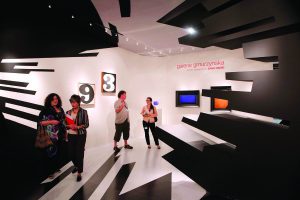A Frisson of the New
By

MIAMI BEACH, FL – DECEMBER 01: A general view of atmosphere at Galerie Gmurzynska Booth designed by Zaha Hadid at Art Basel Miami Beach at the Miami Beach Convention Center on December 1, 2010 in Miami Beach, Florida. (Photo by Elizabeth Burks/Getty Images)
The current cover of Poder Hispanic–a Miami-based monthly magazine subtitled “Intelligence for the Business Elite”–features the Florida mega-collectors Don and Mera Rubell in Warhol fright wigs. It’s headlined “From Swampland to Art Mecca,” and begins, “For years, Miami has been embracing the arts and everything that comes with them. Is this town finally ready to be called a great American city?”
Seth Gordon, managing partner of a Miami business-advisory company, worried within the story that “It’s all built on really shallow foundations. That’s an illusion that can be washed out to sea. It’s not an image that’s deep-rooted and organic, like movies are to Hollywood.”
Michele Oka Doner, the artist and designer whose father was mayor of Miami Beach, will have none of this. “Miami is the city of the 21st century,” she said serenely. And if the arts have been a motor in this town’s transformation, there is a precedent. The uplift that the mythos and business of contemporary art has brought to the life of the city can be compared with the way that Frank Gehry’s Bilbao Guggenheim has transformed the Basque capital. It used to be said that trade followed the flag. Nowadays, you are likely to find that an artist made the flag and a dealer sold it to a collector. Who flipped it.
It was Art Basel Miami’s ninth year in the Miami Beach Convention Center, and there was plenty of pure pleasure to be had, from the Sigmar Polkes at Michael Werner Gallery to the Yves Klein monochrome–in the artist’s copyright IKB color International Klein Blue, natch–at the Zurich gallery, Gmurzynska (bought by collector Aby Rosen), to another luminous monochrome, a leaning plank by John McCracken at David Zwirner.
There were dependable pleasures, but they were safe, and there were fewer shocks than one might have wished for. I remember a couple of fairs ago looking out over the aisles of Art Basel Miami talking with the Los Angeles abstractionist, Ed Moses. “Where’s the angst?” he fretted. “This is all happy-happy stuff.” I mentioned Mr. Moses’ still relevant remark to Ms. Oka Doner this year. “Miami is not Berlin,” she said.
Indeed not. The aisles of the convention center were so crammed with tip-top luxury goods that even the rawness of Jannis Kounellis suits on hangers somehow lost its edge, and business was brisk, if not quite as feverish of yore. Which, considering the still shaky economic conditions worldwide, was itself intensely interesting. Various answers were given to the question of just how many individuals–collectors, not institutions–were keeping the upper levels of the art economy aloft. Five thousand was the consensual total. But Franz Rassler of the Dorotheum (a Viennese auction house) spoke of “between two hundred and a thousand professional collectors,” and Alexis Hubshman, the creator of Scope Art Fair, told me it was “basically just 25 people.”
FOR THE FRISSON of the new, the thrill of the underknown and a sense of things to come, you had to leave the convention center and prowl as many of the 20-plus piggyback fairs as you could stomach. Or wander the urban outdoors where, with Banksy as the paradigm, street artists are devising ever more ingenious ways of bringing themselves to attention.
One of the real eye-opening artworks, though, was to be found by the swellegant pool of the Standard Hotel. Marco Brambilla is not exactly unknown. But Evolution, his new video piece compiled from snippets of film, which he has turned into a polycentric 3-D Hieronymous Bosch-scape, was unlike anything else at Miami Basel.
“I collect a lot of movies. I have a huge library of video film,” Mr. Brambilla told me. “It’s the idea of humanity, beginning and ending simultaneously … the conflict between the past and the future. I look for the right sequence of Clint Eastwood in Dirty Harry. I need an Apache Indian. … I want an astronaut exploding; Mel Gibson in Mad Max; Raquel Welch in One Million Years BC. … I wanted the Red Baron pulling HAPPY FOREVER. And that did take forever to find.
“It’s photo-montage. And then it goes into a machine called the Flare, which can handle up to 900 layers of video in high definition. It’s essentially a hologram.” Did Mr. Brambilla sign up the rights?
“No! No! If I had to get the rights, it would never have happened. My argument would be that the film only occupies a small part of the frame. But it’s such a gray area.” He noted that there’s a snippet from Tropic Thunder with Ben Stiller in his piece, and that he had run into Mr. Stiller at the fair.
“I told him about it. I said, ‘You have to come see it!’
“He said, ‘Yeah? Great!’”
THE CHANGES AT the Design Miami fair have been radical. The fair was pulled in from the Design District and was nose-to-nose with the front door of Art Basel, which was by no means close enough to satisfy designer Ron Arad, who wandered the main fair in his trademark Paddington Bear get-up calling design fairs “design ghettoes” and grumbling that he had a single piece in “the ghetto … unfortunately!”
Here the most remarkable piece was Swarm Light, which is the work of rAndom International, a London-based three-man collective. The piece was inspired by a larger commercial that showed a flock of birds preparing to migrate, and it has evolved into a wholly interactive computerized piece.
You are looking at a cage. You approach and it becomes home to a cloud of individual white lights that flash around in the patterns that will be familiar to anybody who has ever seen a flock of agitated starlings, a shoal of fish or a swarm of midges over a pool in the dusk. The light-creature that inhabits Swarmresponds to your presence–with agitation, even, if you raise your voice. It sold swiftly for $180,000 to a collector who preferred anonymity.
Zoom, a much talked-about fair in the South Seas Hotel, showed artists from the Middle East. Much of the work had a cutting sociopolitical edge, and the reactions of American collectors were wary. “They may not be ready for this fair,” said Kourish Nouri, the owner and director of the Saudi gallery Carbon 12, which contains work by a Saudi woman artist wearing combat gear and a malignant-looking balaclava. “I think it will take four to five years.”
The stand-out in Zoom, I think, was Ahmed Mater, 31, who is also a doctor who lives in Aseer, a region on the Saudi side of the Saudi-Yemen border. A strong piece here, Yellow Cow, is based on the first chapter of the Koran, which references Moses and the Golden Calf. For this piece, Mr. Mater painted a cow saffron to the delight of the villagers–“For me the artwork is the reaction, not the object”–then manufactured such dairy products as cheese and yogurt. He pointed out two words in the label. “Kosher, Halal,” he said. “It is exact same thing”
Mr. Mater added that for the first time, there will be a Saudi pavilion at the next Venice Biennale. It is tough for Saudis to make a living through art, and I wondered whether he would give up doctoring if his international art career prospered? “Most of my artwork is coming from my context. It’s coming from my real life,” he said. “I have a project to photograph the life of the hospital where I work on CCTV.”
There was also strong work in Zoom by Shoja Azari, the Iranian artist, who is married to Shirin Neshat. One was a video, THERE ARE NO NON BELIEVERS IN HELL, which included Renaissance masterworks, the Goya-esque conehead image from Abu Ghraib, black-turbaned mullahs and Christian saints; a taped sermon from a fundamentalist U.S. preacher that Azari unearthed on YouTube belts out at length. “Listen carefully! There are no unbelievers in hell. There are no unbelievers in hell!” Yes, the point seemed to be, we have our jihadist-equivalents, too. There was none of Mr. Moses’ happy-happiness here.
MOST DEALERS WHO managed to tear themselves from their stands said that Miami felt different this year. This was in part because there was such a tremendous build-up of events that even the most VIP-ish of fairgoers just flung up their hands. You didn’t get to the White Cube party? That once-in-a-lifetime P.S.1 party on the beach? So what? “It’s a different mood,” Amanda Sharp, a cofounder of London’s Frieze, said at Scope (where kitsch art, as a rising theme, ruled).
The wealth of non-art events indicated that the decision of Sam Keller, the former doyen of Art Basel, to choose Miami over such other warmer U.S. cities as Los Angeles or Charleston was a canny one because of the nature of Miami itself.
Some years ago, Herbert Muschamp, the then architecture critic of The New York Times, wrote “Miami Beach is no longer a southern city of North America but a northern city of the Latin South.” Along those lines, there was a party to display the collection of Milagros Maldonado–works by Picabia, Botero, Wilfredo Lam, Matta, Manuel Bravo–a Venezuelan whose family holdings were sequestrated by President Chavez.
But curiously, and with such exceptions as a performance by the Cuban collective Los Carpinteros, some pieces by Alfredo Martinez in the White Box space at Scope and Assume Astro Vivid Focus at Wynwood Walls, there was relatively little Latino art at any of the fairs.
It happens that the second “Armory Focus” in 2011, which is the invitational section of the New York big-fair contender, will be upon Latin America. It will include galleries from Argentina, Brazil, Chile, Colombia, Mexico, Peru and Venezuela. Indeed, Katalijne de Backer, director of the Armory Show, who had been coasting the aisles at Miami Basel, announced this with insouciant precision just as dealers were folding their tents at Art Basel Miami.

